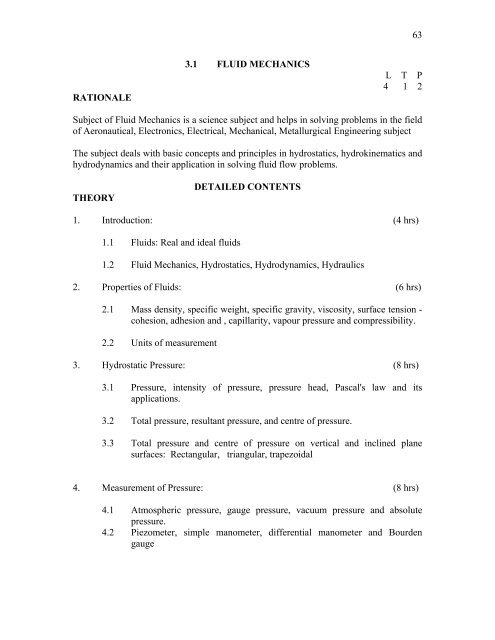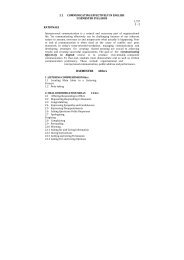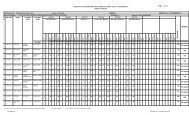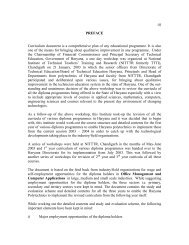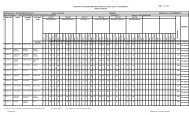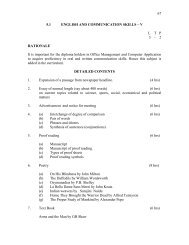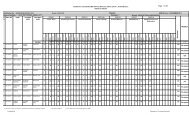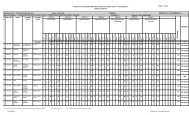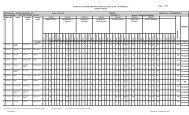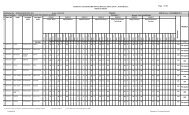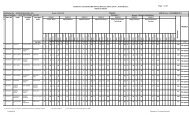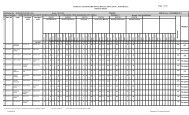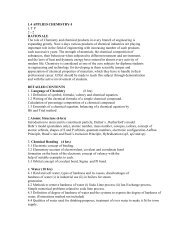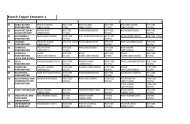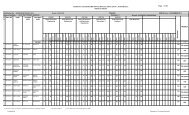63 3.1 FLUID MECHANICS L T P 4 1 2 RATIONALE Subject of ...
63 3.1 FLUID MECHANICS L T P 4 1 2 RATIONALE Subject of ...
63 3.1 FLUID MECHANICS L T P 4 1 2 RATIONALE Subject of ...
You also want an ePaper? Increase the reach of your titles
YUMPU automatically turns print PDFs into web optimized ePapers that Google loves.
645. Fundamentals <strong>of</strong> Fluid Flow: (8 hrs)5.1 Types <strong>of</strong> Flow: Steady and unsteady flow, laminar and turbulent flow,uniform and non-uniform flow5.2 Discharge and continuity equation (flow equation)5.3 Types <strong>of</strong> hydraulic energy: Potential energy, kinetic energy, pressureenergy5.4 Bernoulli's theorem; statement and description (without pro<strong>of</strong> <strong>of</strong> theorem)5.5 Venturimeter (horizontal and inclined6. Flow Measurements (6 hrs)Measurement <strong>of</strong> velocity <strong>of</strong> fluid by:6.1 Venturimeter6.2 Orificemeter6.3 Plot tube6.4 Mouthpiece6.5 Notches and wears6.6 Current meters7. Flow through Pipes: (8 hrs)7.1 Definition <strong>of</strong> pipe flow; , laminar and turbulent flow - explained throughReynold's experiment7.2 Reynolds number, critical velocity and velocity distributions in a pipe forlaminar and turbulent flows7.3 Head loss in pipe lines due to friction, sudden expansion and suddencontraction, entrance, exit, obstruction and change <strong>of</strong> direction (Noderivation <strong>of</strong> formula)7.4 Hydraulic gradient line and total energy line7.5 Flow from one reservoir to another through a long pipe <strong>of</strong> uniform crosssection (simple problems)
7011. Domestic Installation: (4 hrs)11.1 Distinction between light and fan circuits and single phase power circuit,sub circuits11.2 Various accessories and parts <strong>of</strong> installation, identification <strong>of</strong> wiringsystems11.3 Common safety measures and earthing11.4 Introduction to BIS code <strong>of</strong> safety and wiring installation12. Electric Motors and Pumps: (5 hrs)12.1 Definition and various application <strong>of</strong> single phase and three phase motors12.2 Connection and starting <strong>of</strong> three phase motors by star delta starter12.3 Conversion <strong>of</strong> horse power in watts or kilowatts12.4 Type <strong>of</strong> pumps and their applicationsPRACTICAL EXERCISES IN ELECTRICAL ENGINEERING:1. Use <strong>of</strong> Megger:Objective: To make the students familiar with different uses <strong>of</strong> megger2. Connection <strong>of</strong> a three phase motor and starter including fuses and reversing <strong>of</strong>direction <strong>of</strong> rotation.Objective: Students may be made familiar with the equipment needed tocontrol a three-phase motorThe students must experience that by changing any two phases, thedirection <strong>of</strong> rotation is reversed.3. Connection <strong>of</strong> a lamp, ceiling fan, socket outlet, geyser, floor grinder, voltagestabliser etc.Objective: Students may be made familiar with the different types <strong>of</strong>equipment and circuits used in the domestic installations4. Trouble shooting in a three-phase motorNote: The teacher may create anyone <strong>of</strong> the following faults(a) Loose connections(b) Blown fuse(c) Tripped overload protection(d) Incorrect direction <strong>of</strong> rotation(e) Single phasing(f) Burnt winding to be simulated by a loose connection behind aterminal box.Objective: The students must be able to detect the most common faults, whichmay occur in a three-phase motor, using meggar wherevernecessary
715. Trouble shooting in a domestic wiring system.Note: The teacher may introduce a fault in the existing wiring system <strong>of</strong> aclassroom or workshop like(a) blown fuse(b) loose connection(c) faulty components/accessories etc.Objective: Students must be able to detect common faults which may occurin a domestic wiring system6. Treatment <strong>of</strong> electric shockNote: The teacher may give a demonstration how an electric shock mustbe treated.Objective:Students must be trained to treat the persons suffering from anelectric shock7. Study <strong>of</strong> a distribution BoardNote: Students may be asked to study the distribution board in theinstitution and note down all accessories.Objective: Students must be made familiar with the distribution board8. Connections and reading down an energy meterObjective: Students may be asked to connect an energy meter to a load andcalibrate reading9. Demonstration in electrical machine laboratoryObjective: Students may be shown different types <strong>of</strong> electrical machines andtheir starters and should be told that the three phase inductionmotors are most commonly used.10. Study <strong>of</strong> submersible motor pump set:Objective: To tell use <strong>of</strong> the set in water supply and irrigation works.CIVIL ENGINEERINGPART CTheory13. Construction Materials (10 hrs)Basics <strong>of</strong> various construction materials such as stones, bricks, lime, cement andtimber along with their properties, physical/ field testing and uses, elements <strong>of</strong>brick masonry.14. Foundations (8 hrs)i) Bearing capacity <strong>of</strong> soil and its importance
72ii)Types <strong>of</strong> various foundations and their salient features, suitability <strong>of</strong>various foundations for heavy, light and vibrating machines15. Concrete (8 hrs)Various ingredients <strong>of</strong> concrete, different grades <strong>of</strong> concrete, water cement ratio,workability, physical/ field testing <strong>of</strong> concrete, mixing <strong>of</strong> concrete16. RCC (4 hrs)Basics <strong>of</strong> reinforced cement concrete and its use (elementary knowledge),introduction to various structural elements <strong>of</strong> a buildingPRACTICAL EXERCISES IN CIVIL ENGINEERINGTesting <strong>of</strong> bricksa) Shape and sizeb) Soundness testc) Water absorptiond) Crushing strengthTesting <strong>of</strong> concretea) Slump testb) Compressive Strength <strong>of</strong> concrete cube3. The students should be taken to different construction sites to show them variousconstruction materials, concreting process and construction <strong>of</strong> RCC structuralelements, foundations and other civil worksNote: While imparting instructions, teachers are expected to lay more emphasis onconcepts and principles. It will be better if the classes for general engineering areconducted in the laboratories and organized demonstrations for explaining variousconcepts and principles.RECOMMENDED BOOKSMechanical Engineering1. General Mechanical Engineering by M. Adithan; TTTI, Chandigarh2. Basic Civil and Mechanical Engineering by Jayagopal; Vikas Publications, NewDelhi3. IC Engines and Automobile Engineering by Dr.MP Poonia, Standard Publishers,New Delhi4. Refrigeration and Air Conditioning by RK Rajput; SK Kataria and sons; Ludhiana
735. Theory <strong>of</strong> Machines by RS Khurmi and JK Gupta; S. Chand and Company Ltd.,New DelhiElectrical Engineering1. Electrical Technology Part 1: Basic Electrical Engineering by Theraja, BL; SChand and Company, New Delhi2. Principles <strong>of</strong> Electrical Engineering by Gupta BR, S Chand and Company, NewDelhi3. Basic Electrical Engineering by Mehta VK; S Chand and Company, New Delhi4. Basic Electricity and Measurements by Suryanarayan NV and N Delhi; TataMcGraw Hill, 1987, New Delhi5. Basic Electrical and Electronics Engineering by SK Sahdev; Dhanpat Rai andsons, New Delhi6. Basic Electrical Engineering by PS Dhogal, Tata McGraw Hill, New Delhi7. Basic Electricity by BR Sharma; Satya Parkashan, New DelhiCivil Engineering1. Textbook <strong>of</strong> Concrete Technology 2 nd Edition by Kulkarni, PD Ghosh RK andPhull, YR; New Age International (P) Ltd., Publishers, New Delhi2. Materials <strong>of</strong> Construction by Ghose; Tata McGraw Hill Publishing Co., Ltd., NewDelhi3. Civil Engineering Materials by TTTI, Chandigarh; Tata McGraw Hill PublishingCo. Ltd., New Delhi4. Concrete Technology by Gambhir; Tata McGraw Hill Publishing Co., Ltd., NewDelhi5. Building Construction by J Jha and Sinha; Khanna Publishers, Delhi6. Building Construction by Vazirani and Chandola; Khanna Publishers, Delhi7. Civil Engineering Materials by SV Deodhar and Singhai; Khanna Publishers,Delhi8. Soil Mechanics and foundation Engineering by SK Garg; Khanna Publishers,Delhi
74<strong>RATIONALE</strong>3.3 SURVEYING - IL T P2 - 6The important functions <strong>of</strong> a diploma civil engineer includes the jobs <strong>of</strong> detailedsurveying, plotting <strong>of</strong> survey data, preparation <strong>of</strong> survey maps and setting out worksWhile framing the curriculum for the subject <strong>of</strong> surveying, stress has been given to thedevelopment <strong>of</strong> the skill in each type <strong>of</strong> survey like chain surveying, compass surveyingand levelling that the Civil Engineering diploma holder will normally be called upon toperform. Plane table surveying, contouring, theodilite surveying, curves and use <strong>of</strong> minorinstruments have been also included in this subject.Field work should be a selected one so that student can check his work and have an idea<strong>of</strong> the results the extent <strong>of</strong> error in the work done by him. As far as possible, the surveysdone should be got plotted, as this will also reveal errors in the work and develop skill inplotting.DETAILED CONTENTSTHEORY1. Introduction: (3 hrs)1.1 Basic principles <strong>of</strong> surveying1.2 Concept and purpose <strong>of</strong> surveying, measurements-linear and angular, units<strong>of</strong> measurements1.3 Instruments used for taking these measurements, classification <strong>of</strong> surveybasedon instruments2. Chain surveying: (3 hrs)2.1 Purpose <strong>of</strong> chain surveying, principles <strong>of</strong> chain surveying2.2 Obstacles in chain surveying2.5.1 Errors in chain surveying2.5.2 Correction for measurements by erroneous length <strong>of</strong> chain, simpleproblems on this.
753. Compass surveying: (8 hrs)<strong>3.1</strong> Purpose <strong>of</strong> compass surveying. Construction and working <strong>of</strong> prismaticcompass, use <strong>of</strong> prismatic compass: Setting and taking observations3.2 Concept <strong>of</strong>:a) Meridian - Magnetic and trueb) Bearing - Magnetic, True and Arbitraryc) Whole circle bearing and reduced bearingd) Fore and back bearinge) Magnetic dip and declination3.3 Local attraction - causes, detection, errors and corrections, problems onlocal attraction, magnetic declination and calculation <strong>of</strong> included angles ina compass traverse3.4 Concept <strong>of</strong> a traverse - Open and closed. Traversing with a compass.Checks for an open and closed traverse, plotting a traverse - By includedend deflection angles, concept <strong>of</strong> closing error, adjustment <strong>of</strong> traversegraphically by proportionate method,4. Levelling: (10 hrs)4.1 Purpose <strong>of</strong> levelling, concept <strong>of</strong> a level surface, horizontal surface, verticalsurface, datum, reduced level and bench marks4.2 Principle and construction <strong>of</strong> Dumpy level4.3 Concepts <strong>of</strong> line <strong>of</strong> collimation, axis <strong>of</strong> the bubble tube, axis <strong>of</strong> thetelescope and vertical axis4.4 Levelling staff: single piece, folding, invar precision staff, telescopic4.5 Temporary adjustment: setting up and leveling, adjusting for parallax <strong>of</strong>Dumpy4.6 Concept <strong>of</strong> back sight, foresight, intermediate sight, station change point,to determine reduce levels4.7 Level book and reduction <strong>of</strong> levels by4.7.1 Height <strong>of</strong> collimation method and4.7.2 Rise and fall method4.8 Arithmetic checks, problem on reduction <strong>of</strong> levels, fly levelling, checkleveling and pr<strong>of</strong>ile levelling (L-section and X-section), errors in levelling,
76and precautions to minimize them and permissible limits, reciprocallevelling, testing and adjustment <strong>of</strong> IOP level. Numerical Problems.4.9 Computations <strong>of</strong> Areas <strong>of</strong> regular figure and irregular figure. Simpsonrule: prismoidel formula and graphical method, use <strong>of</strong> planimeter5. Plane Table Surveying: (8 hrs)5.1 Purpose <strong>of</strong> plane table surveying, equipment used in plane table survey:(a) Plane table(b) Alidade (Plain and Telescopic)(c) Accessories5.2 Setting <strong>of</strong> a plane table:(a) Centering(b) Levelling(c) Orientation5.3 Methods <strong>of</strong> plane table surveying(a) Radiation,(b) Intersection(c) Traversing(d) Resection5.4 Two point problem5.5 Three point problem bya) Mechanical Method(Tracing paper)b) Bessel's Graphical Methodc) Trial and error method and Lehman’s RulesErrors in plane table survey and precautions to control them. Testing andadjustment <strong>of</strong> plane table and alidadePRACTICAL EXERCISESI. Chain surveying:i) a) Ranging a lineb) Chaining a line and recording in the field workc) Testing and adjustment <strong>of</strong> chaind) Taking <strong>of</strong>fsets - perpendicular and oblique (with a tape only)e) Setting out right angle with a tapeii) a) Chaining <strong>of</strong> a line involving reciprocal rangingb) Taking <strong>of</strong>f sets and setting out right angles, with cross staff andIndian optical square
77iii)iv)Chain survey <strong>of</strong> a small area (field work and plotting)Chaining a line involving obstacles to rangingII.Compass Surveying:i) a) Study <strong>of</strong> prismatic compassb) Setting the compass and taking observationsc) Measuring angles between the lines meeting at a pointii)Traversing with the prismatic compass and chain (Recording and plottingby included angles)III.Levelling:i) a) Study <strong>of</strong> dumpy level and levelling staffb) Temporary adjustments <strong>of</strong> a Dumpy levelc) Taking staff readings on different stations from the single settingand finding differences <strong>of</strong> level between themii) a) Study <strong>of</strong> IOP levelb) Its temporary adjustmentsc) Taking staff readings on different stations from the single settingand finding differences <strong>of</strong> level between themiii)iv)Longitudinal and cross sectioning <strong>of</strong> a road/railway/canalSetting a gradient by dumpy and IOP levelIV.Plane Table Surveying:i) a) Study <strong>of</strong> the plane table survey equipmentb) Setting the plane tablec) Marking the North directiond) Plotting a few points by radiation methodii) a) Orientation by- Trough compass- Back sightingb) Plotting few points by intersection methodiii)Traversing an area with a plane table (at least five lines)iv) a) Two point problemb) Three point problem by
78- Tracing paper method- Bessel's graphical method- Trial and Error methodv) Setting and checking grades with abney level. Setting and checking gradeswith Ceylon Ghat Tracervi)vii)Finding heights by Indian Pattern Clinometer (Tangent Clinometer)Enlargement/ reduction <strong>of</strong> a plan by the use <strong>of</strong> pentagraphUse <strong>of</strong> planimeter for computing areasINSTRUCTIONAL STRATEGYThis is highly practice-oriented course. While imparting theoretical instructions, teachersare expected to demonstrate the use <strong>of</strong> various instruments in surveying, stress should belaid on correct use <strong>of</strong> various instruments so as to avoid/minimize errors duringsurveying. It is further recommended that more emphasis should be laid in conductingpractical work by individual studentsRECOMMENDED BOOKSi) Narinder Singh; "Surveying"; New Delhi, Tata McGraw Hill Publishing Co Ltd.ii)iii)iv)Hussain, SK and Nagraj, MS; "Text Book <strong>of</strong> Surveying"; New Delhi, S Chandand Co Ltd.Deshpande, RS; "A Text Book Surveying and Levelling"; Poona, United BookCorporationKocher, CL; "A Text Book <strong>of</strong> Surveying"; Ludhiana, Katson Publishing Housev) Kanetkar,TP and Kulkarni, SV., "Surveying and Leveling", Poona, AVGParkashanvi)vii)viii)Kanetkar, TP; and Kulkarni, SV; "Surveying and Leveling-Vol.2" Poona, AVGPrakashanPunmia, BC; "Surveying and Leveling - Vol. 2", Delhi Standard PublishersDistributors, DelhiShahai, PB; "A Text Book <strong>of</strong> Surveying Vol. 2", Oxford and IBH PublishingCo.
793.4 CONSTRUCTION MATERIALS<strong>RATIONALE</strong>L T P3 - 2Civil Engineering diploma holders have to supervise construction <strong>of</strong> various types<strong>of</strong> civil works involving use <strong>of</strong> various materials like stones, bricks and tiles, cementand cement based products, lime, timber and wood based products, paints andvarnishes metals and other miscellaneous materials. The students should have requisiteknowledge regarding characteristics, uses and availability <strong>of</strong> various buildingmaterials and skills in conducting tests to determine suitability <strong>of</strong> materials for variousconstruction purposes. In addition specifications <strong>of</strong> various materials should also beknown (PWD/BIS) for effective quality control.THEORYDETAILED CONTENTS1. Building Stones: (4 hrs)1.1 Classification <strong>of</strong> Rocks: (General Review)1.1.1 Geological classification: Igneous, sedimentary and metamorphicrocks1.1.2 Chemical classification; Calcareous, argillaceous and siliceousrocks1.1.3 Physical classification: Unstratified, startified and foliated rocks1.2 General characteristics <strong>of</strong> stones – Marble, Granite, Sand stone, Limestone and Slate1.3 Requirements <strong>of</strong> good building stones**1.4 Identification <strong>of</strong> common building stones1.5 Various uses <strong>of</strong> stones in construction1.6 Kota stone, marble2. Bricks and Tiles: (10 hrs)2.1 Introduction to bricks
802.2 Raw materials for brick manufacturing and properties <strong>of</strong> good brickmaking earth2.3 Manufacturing <strong>of</strong> bricks2.<strong>3.1</strong> Preparation <strong>of</strong> clay (manual/mechanically)**2.3.2 Moulding: hand moulding and machine moulding, handmoulding brick table; drying <strong>of</strong> bricks, burning <strong>of</strong> bricks, types<strong>of</strong> kilns (Bull's Trench Kiln and H<strong>of</strong>fman's Kiln), process <strong>of</strong>burning, size and weight <strong>of</strong> standard brick; traditionalbrick, refractory brick, clay-flyash bricks, sun dried bricks, onlyline diagram <strong>of</strong> kilns2.4 Classification and specifications <strong>of</strong> bricks as per BIS: 10772.5 Testing <strong>of</strong> common building bricks as per BIS: 34952.6 TilesCompressive strength, water absorption – hot and cold water test,efflorescence, Dimensional tolerance2.6.1 Building tiles; Types <strong>of</strong> tiles-wall, ceiling, ro<strong>of</strong>ing and flooringtiles2.6.2 Ceramic, linoleum, terrazo and PVC tiles, their properties and uses2.7 Stacking <strong>of</strong> bricks and tiles at site3. Cement: (7 hrs)**<strong>3.1</strong> Introduction, raw materials, flow diagram <strong>of</strong> manufacturing <strong>of</strong> cement,by wet process3.2 Various types <strong>of</strong> Cements and their uses: Ordinary portland cement, rapidhardening cement, low heat cement, high alumina cement, blast furnaceslag cement, white and coloured cement, portland pozzolana cement, supersulphated cement3.3 Properties <strong>of</strong> cement3.4 Storage <strong>of</strong> Cement4. Lime: (4 hrs)4.1 Introduction: Lime as one <strong>of</strong> the cementing materials
814.2 Definition <strong>of</strong> terms; quick lime, fat lime, hydraulic lime, hydrated lime,lump lime4.3 Calcination and slaking <strong>of</strong> lime4.4 IS classification <strong>of</strong> lime5. Timber and Wood Based Products: (7 hrs)5.1 Identification <strong>of</strong> different types <strong>of</strong> timber: Teak, Deodar, Shisham, Sal,Mango, Kail and Chir** 5.2 Market forms <strong>of</strong> converted timber as per BIS5.3 Seasoning <strong>of</strong> timber: Purpose, methods <strong>of</strong> seasoning, kiln seasoning asper BIS5.4 Defects in timber, decay in timber5.5 Preservation <strong>of</strong> timber and methods <strong>of</strong> treatment as per BIS5.6 Properties <strong>of</strong> timber and specifications <strong>of</strong> structural timber**5.7 Common timbers in India, their uses - Teak, Deodar, Chir, Kail, Shisham,Sal and Mango, Plywood; Veneers and veneering, manufacturing <strong>of</strong>plywood (brief description only), uses <strong>of</strong> plywood.5.8 Other wood based products, their brief description <strong>of</strong> manufacture anduses: laminated board, black board, fibre board, hard board6. Paints and Varnishes: (6 hrs)6.1 Purpose and use <strong>of</strong> paints6.2 Different types <strong>of</strong> paints: oil paints, water paints and cement paints6.2.1 Cement paints - commonly available cement paints, theirproperties and uses. Application <strong>of</strong> Cement paints6.2.2 Varnishes and polish-types, properties and their uses.6.2.3 Lacquers and enamels - their properties and uses.6.2.4 Oil paints: their properties and uses7. Metals: (4 hrs)7.1 Ferrous metals: Composition, properties and uses <strong>of</strong> cast iron, steel(mild and high tension steel), requirements <strong>of</strong> mild steel as per BIS.
827.2 Non Ferrous metals: properties and uses <strong>of</strong> the following non ferrousmetals in Civil Engineering works - copper, lead, zinc, tin and aluminium7.3 Commercial forms <strong>of</strong> ferrous and non ferrous metals.8. Miscellaneous Materials: (6 hrs)8.1 Plastics: Important commercial products <strong>of</strong> plastics used in CivilEngineering construction.8.2 Asbestos based products: Commercial forms and their uses (Asbestos tiles,fibre boarded, cellotex)8.3 Insulating materials for Sound and Thermal Insulation8.4 Construction chemicals like: water pro<strong>of</strong>ing components, epoxies,sulphides, polymers.8.5 Glass: Types <strong>of</strong> glasses, their properties, Commercial forms and uses:plate glass, wired glass, bullet resisting glass, coloured glass, fibreglass, foamed glass, glass wool, Float glass, glass reinforced plastic.8.6 Water pro<strong>of</strong>ing materials; Bitumen sheets and felts, chemical admixtures**8.7 Finishings Materials: Homogenous laminated fibres, panel boards, wallboards, wall papers etcNOTE:**A field visit may be planned to explain and show the relevant thingsPRACTICAL EXERCISES:i) To identify different types <strong>of</strong> stonesii)iii)iv)To determine the crushing strength <strong>of</strong> bricksTo determine the water absorption <strong>of</strong> bricksTo identify various types <strong>of</strong> timbers such as: Teak, Sal, Chir, Sissoo, Deodar,Kail & Hollockv) To determine fineness (by sieve method) <strong>of</strong> cementvi)vii)To determine normal consistency <strong>of</strong> cementTo determine initial and final setting times <strong>of</strong> cement
83viii)ix)To determine soundness <strong>of</strong> cementTo determine compressive strength <strong>of</strong> cementINSTRUCTIONAL STRATEGYTeachers are expected to physically show various materials while imparting instructions.Field-visits should also be organized to show manufacturing processes and use <strong>of</strong> variousmaterials in Civil engineering works. Students should be encouraged to collect sample <strong>of</strong>various building materials so as to create a museum <strong>of</strong> materials in the polytechnic.RECOMMENDED BOOKS1) TTTI, Chandigarh "Civil Engineering Materials:" Tata McGraw Hill Publication2) Surendra Singh; "Engineering Materials;" New Delhi, Vikas Publishing HousePvt. Ltd.3) Chowdhuri, N; "Engineering Materials;" Calcutta, Technical Publishers <strong>of</strong> India.4) Bahl, SK; "Engineering Materials;" Delhi, Rainbow Book Co.5) Sharma, SK; and Mathur, GC; "Engineering Materials;" Delhi-Jalandhar, R.Chand and Co.6) Kulkarni, GJ; "Engineering Materials;" Ahmedabad, Ahmedabad Book Depot.7) Shahane; Engineering Materials; Poona, Allied Book Stall.8) Gurcharan Singh; Engineering materials, Standard Publishers Distributors
84<strong>RATIONALE</strong>3.5 BUILDING CONSTRUCTIONL T P4 - -Diploma holders in Civil Engineering are supposed to supervise construction <strong>of</strong>buildings. To perform above task, it is essential that students should have knowledge <strong>of</strong>various sub components <strong>of</strong> buildings like foundations, walls, ro<strong>of</strong>s, stair cases, floors etc.,and their constructional details. Therefore, the subject <strong>of</strong> Building Construction is veryimportant for Civil Engineering diploma holders.THEORY:DETAILED CONTENTS1. Introduction: (1 hr)1.1 Definition <strong>of</strong> a building, classification <strong>of</strong> buildings based on occupancy1.2 Different parts <strong>of</strong> a building2. Foundations: (4 hrs)2.1 Concept <strong>of</strong> foundation and its purpose2.2 Types <strong>of</strong> foundation-shallow and deep**2.2.1 Shallow foundation - constructional details <strong>of</strong>: Spread foundationsfor walls, thumb rules for depth and width <strong>of</strong> foundation andthickness <strong>of</strong> concrete block, stepped foundation, masonary pillarsand concrete columns, raft foundation,2.2.2 Deep foundations; Pile foundations - their suitability(This topic may be demonstrated with the help <strong>of</strong> transparencies)2.2 Earthwork2.<strong>3.1</strong> Surface excavation, definition, setting out, cutting, filling andblasting2.3.2 Excavation <strong>of</strong> foundation, trenches, shoring, timbering and dewatering3. Walls: (4 hrs)<strong>3.1</strong> Purpose <strong>of</strong> walls3.2 Classification <strong>of</strong> walls - load bearing, non-load bearing, dwarf, retaining,breast walls and dhaji walls
853.3 Classification <strong>of</strong> walls as per materials <strong>of</strong> construction: brick, stone,reinforced brick, reinforced concrete, precast, hollow and solid concreteblock and composite masonry walls3.4 Partition walls: Constructional details, suitability and uses <strong>of</strong> brick andwooden partition walls3.5 Mortars: types, selection <strong>of</strong> mortar and its preparation3.6 Scaffolding, construction details and suitability <strong>of</strong> mason’s brick layers andtubular scaffolding, shoring, underpinning4. Masonry (8 hrs)4.1 Brick Masonry: Definition <strong>of</strong> terms, bond, facing, backing, hearting,column pillar, jambs, reveals s<strong>of</strong>fit, plinth masonry, header, stretcher, bed<strong>of</strong> bricks bat, queen closer, king closer, frog and quoin4.1.1 Bond – meaning and necessity; English and flemish bond4.1.2 Construction <strong>of</strong> brick walls –methods <strong>of</strong> laying bricks in walls,precautions observed in the construction <strong>of</strong> walls, methods <strong>of</strong>bonding new brick work with old (toothing, racking, back andblock bonding), Expansion and contraction joints4.2 Stone Masonry4.2.1 Glossary <strong>of</strong> terms – natural bed, bedding planes, string course,corbel, cornice, block in course grouting, moulding, templatesthroating, thorugh stone parapet, coping, plaster and buttress4.2.2 Types <strong>of</strong> stone masonry, rubble masonry, random and coursedashlar masonry, principles to be observed in construction <strong>of</strong> stonemasonry walls5. Arches and Lintels: (4 hrs)5.1 Meaning and use <strong>of</strong> arches and lintels:5.2 Glossary <strong>of</strong> terms used in arches and lintels - abutment, peir, arch ring,intrados, s<strong>of</strong>fit, extrados, voussoiers, springer, springing line, crown, keystone, skew back, span, rise, depth <strong>of</strong> an arch, haunch, spandril,jambs, bearing, thickness <strong>of</strong> lintel, effective span5.3 Arches:5.<strong>3.1</strong> Types <strong>of</strong> Arches - Semi circular, segmental, elliptical andparabolic, flat, inverted and relieving
865.3.2 Stone arches and their construction5.3.3 Brick arches and their construction5.4 Lintels5.4.1 Purpose <strong>of</strong> lintel5.4.2 Materials used for lintels: RCC, RBC, stone, steel and timber5.4.3 Cast-in-situ and pre-cast lintels5.4.4 Lintel along with sun-shade or chhajja**6. Doors, Windows and Ventilators: (2 hrs)6.1 Glossary <strong>of</strong> terms6.2 Classification and their suitability for different situations*7. Damp Pro<strong>of</strong>ing and Water Pro<strong>of</strong>ing (6 hrs)7.1 Dampness and its ill effects on bricks, plaster, wooden fixtures, metalfixtures and reinforcement, damage to asthetic appearance, damage to heatinsulating materials, damage to stored articles and health, sources andcauses <strong>of</strong> dampness7.2 Types <strong>of</strong> dampness - moisture penetrating the building from outside e.g.rainwater, surface water, ground moisture7.3 Moisture entrapped during construction i.e. moisture in concrete, masonryconstruction and plastering work etc.7.4 Moisture which originates in the building itself i.e. water in kitchen andbathrooms etc.7.5 Damp pro<strong>of</strong>ing materials and their specifications: rich concrete andmortar, bitumen, bitumen mastic, polymer coating, use <strong>of</strong> chemicals7.6 Damp pro<strong>of</strong>ing <strong>of</strong> : basement, ground floors, plinth and walls, specialdamp pro<strong>of</strong>ing arrangements in bathrooms, WC and kitchen, damppro<strong>of</strong>ing for ro<strong>of</strong>s and window sills**8. Floors (6 hrs)8.1 Glossary <strong>of</strong> terms-floor finish, topping, under layer, base course, rubblefilling and their purpose8.2 Types <strong>of</strong> floor finishes - cast-in-situ, concrete flooring (monolithic,bonded) Terrazo tile flooring, stone (marble and kota) flooring, PCV
87flooring, Terrazo flooring, Timber flooring, description with sketches <strong>of</strong>the methods <strong>of</strong> construction <strong>of</strong> the floors and their specifications9. Ro<strong>of</strong>s (6 hrs)9.1 Glossary <strong>of</strong> terms for pitched ro<strong>of</strong>s - batten, eaves, barge, facia board,gable, hip, lap, purlin, rafter, rag bolt, valley, ridge9.2 Types <strong>of</strong> ro<strong>of</strong>s, concept <strong>of</strong> flat, pitched and arched ro<strong>of</strong>s9.3 Ceilings – Gypsum, plaster boards, cellotex, fibre boards10. Stairs (4 hrs)10.1 Glossary <strong>of</strong> terms: Staircase, winders, landing, stringer, newel, baluster,riser, tread, width <strong>of</strong> staircase, hand-rail, nosing10.2 Classifica tion <strong>of</strong> staircase on the basis <strong>of</strong> material – RCC, timber, steel,Aluminium10.3 Planning and layout <strong>of</strong> staircase: Relations between rise and tread,determination <strong>of</strong> width <strong>of</strong> stair, landing etc10.4 Various types <strong>of</strong> layout - straight flight, dog legged, open well, quarterturn, half turn (newel and geometrical stairs), bifurcated stair, spiral stair11. Surface Finishes (6 hrs)11.1 Plastering - classification according to use and finishes like grit finish,rough cast, pebble dashed, concrete and stone cladding, plain plaster etc.,dubbing, proportion <strong>of</strong> mortars used for different plasters, techniques <strong>of</strong>plastering and curing11.2 Pointing - different types <strong>of</strong> pointing and their method11.3 Painting - preparation <strong>of</strong> surface priming coat and application <strong>of</strong> paintson wooden, steel and plastered wall surfaces11.4 White washing, colour washing and distempering, polishing, application<strong>of</strong> cement and plastic paints11.5 Commonly used water repellent for exterior surfaces, their names andapplications
8812. Anti Termite Measures (As per IS <strong>63</strong>13 –I – III) (4 hrs)12.1 Introduction, site preparation and chemicals used in anti-termite treatment12.2 Treatment <strong>of</strong> masonry foundation12.3 Treatment <strong>of</strong> RCC foundation12.4 Treatment <strong>of</strong> top surface <strong>of</strong> earth filling12.5 Treatment <strong>of</strong> junction <strong>of</strong> walls and floors12.6 Treatment along external perimeter <strong>of</strong> building12.7 Treatment and selection <strong>of</strong> timber12.8 Treatment in existing buildings13. Building Planning (4 hrs)1<strong>3.1</strong> Site selection: Factors to be considered for selection <strong>of</strong> site for residential,commercial, industrial and public building13.2 Basic principles <strong>of</strong> building planning, arrangement <strong>of</strong> doors, windows,cupboards etc for residential building13.3 Orientation <strong>of</strong> building as per IS: 7662 in relation to sun and winddirection, rains, internal circulation and placement <strong>of</strong> rooms within theavailable area.13.4 Planning <strong>of</strong> building services14. Repair and Maintenance <strong>of</strong> Buildings (4 hrs)14.1 Introduction14.2 Importance <strong>of</strong> repair and maintenance <strong>of</strong> buildings14.3 Common repair problems and their solutions14.4 Cracks in buildings14.5 Repair <strong>of</strong> DPC against rising dampness14.6 Repair and maintenance <strong>of</strong> public health services14.7 Types <strong>of</strong> materials for building repairsNote * An expert may be invited from field/industry for extension lecture** A field visit may be planned to explain and show the relevant things
89Demonstration and site visits should be done for following:i) Demonstration <strong>of</strong> tools and plants used in building constructionii)iii)iv)Layout <strong>of</strong> a building: two rooms building with front verandahTo construct brick bonds (English bond only) in one, one and half and two brickthick: (a) Walls for L, T and cross junction (b) ColumnsDemonstration <strong>of</strong> pre-construction and post-construction termite treatment <strong>of</strong>building and woodworkv) Demonstration <strong>of</strong> following items <strong>of</strong> work at construction site:a) Timbering <strong>of</strong> excavated trenchingb) Damp pro<strong>of</strong> coursesc) Construction <strong>of</strong> masonry wallsd) Flooring: Laying <strong>of</strong> \flooring on an already prepared lime concrete basee) Plastering and pointingf) White and colour washingg) Use <strong>of</strong> special type <strong>of</strong> shuttering/cranes/heavy machines in constructionworkh) RCC workINSTRUCTIONAL STRATEGYWhile imparting instructions in this subject, teachers are expected to take students towork site and explain constructional process and special details for various subcomponents<strong>of</strong> a buildings. It is also important to make use <strong>of</strong> audio visual aids/vide<strong>of</strong>ilms (if available) to show specialised operations. The practical work should be givendue importance and efforts should be made that each student should perform practicalwork independently. For carrying out practical works, polytechnics should have buildingyard where enough raw materials is made available for students to perform practical workRECOMMENDED BOOKS1. Gupta, Sushil Kumar, Singla, DR, and Juneja BM; "A Text Book <strong>of</strong> BuildingConstruction"; Ludhiana, Katson Publishing House.2. Deshpande, RS and Vartak, GV; "A Text Book <strong>of</strong> Building Construction"; Poona,United Book Corporation.3. Rangwala, SC: "Building Construction"; Anand, Charotar Book Stall4. Kulkarni, GJ; "A Text Book <strong>of</strong> Building Construction"; Ahmedabad Book Depot
905. Arora, SP and Bindra, SP; "A Text Book <strong>of</strong> Building Construction"; New DelhiDhanpt Rai and Sons.6. Sharma,SK and Kaul, BK; "A Text Book <strong>of</strong> Building Construction"; Delhi, SChand and Co.7. Sushil Kumar; "Building Construction"; Standard Publishers Distributors, Delhi8. Moorthy, NKR; "A Text Book <strong>of</strong> Building Construction"; Poona, EngineeringBook Publishing Co.9. SP – 62 Hand Book <strong>of</strong> BIS10. Singh Gurcharan, “Building Materials”, Standard Publishers Distributor, Delhi11. B.I.S. – <strong>63</strong>13 Part 1, 2, 3
913.6 BUILDING DRAWING<strong>RATIONALE</strong>L T P- - 6Drawing is the language <strong>of</strong> engineers. Engineering is absolutely incomplete without athorough knowledge <strong>of</strong> drawing. A Civil Engineering diploma holder must be capable <strong>of</strong>sketching detailed constructional drawing <strong>of</strong> various components <strong>of</strong> building for thepurpose <strong>of</strong> communication with the craftsman. Planning <strong>of</strong> small buildings, developing aline plan, dimensioning, key plan, drainage plan should be a part <strong>of</strong> curriculum. Thediploma engineer must be conversant with reading and interpretation <strong>of</strong> drawing forexecution <strong>of</strong> work.DETAILED CONTENTSDrawing No. 1:Section-IDetails <strong>of</strong> spread footing foundations for load bearing and non-load bearing wall forgiven thickness <strong>of</strong> walls with the help <strong>of</strong> given data or rule <strong>of</strong> the thumb, showing <strong>of</strong>fsets,position <strong>of</strong> DPC; details <strong>of</strong> basement showing necessary damp pro<strong>of</strong>ing. (3 x 3 = 9)Drawing No. 2:Plans <strong>of</strong> ‘T’ and Corner junction <strong>of</strong> walls 1 Brick, 1-1/2 Brick and 2 brick thick inEnglish bond (2 x 4 = 8)Drawing No. 3:Elevation, sectional plan and sectional side elevation <strong>of</strong> flush door, panelled door,panelled and glazed door, edged, battened and braced-door, steel windows andalumunium windows (2 x 4 = 8)Drawing No. 4:Section-IISteel ro<strong>of</strong> truss (king post, queen post) showing details <strong>of</strong> joints, fixation <strong>of</strong> ro<strong>of</strong>coverings, eaves and gutters. (2 x 4 = 8)Drawing No. 5:Drawing plan, elevation <strong>of</strong> a small building by measurement. (2 x 4 = 8)
92Drawing No. 6:Drawing detailed plan, elevation and section <strong>of</strong> a two room residential building from agiven line plan, showing details <strong>of</strong> foundations, ro<strong>of</strong> and parapet using AutoCAD(3 x 4 = 12)Drawing No. 7:Drawings <strong>of</strong> following floorsa) Cement concrete floors on ground and at first floori) Conglomerateii) Bonded cement concrete flooringiii) Terrazo flooringb) Wooden floorsi) Single wooden floorsii) Double wooden floors on ground and first floor (3 x 4 = 12)Drawing No. 8:Section-IIIDrawing plan and section <strong>of</strong> a dog legged stair (RCC), quarter turn stair in a given room(2 x 4 =8)Drawing No. 9:Drawing a small double storey building with a RCC slab ro<strong>of</strong>, sloping ro<strong>of</strong> showingposition <strong>of</strong> sanitary fittings house drainage and electrical fittings (4 x 4 = 16)Drawing No. 10:Drawing details <strong>of</strong> damp pro<strong>of</strong>ing arrangement <strong>of</strong> ro<strong>of</strong>s, floors, basement and walls asper BIS CodeNOTE:a) All drawings should be as per BIS code and specifications in SI Unitsb) Intensive practice <strong>of</strong> reading and interpreting building drawings should be given
93RECOMMENDED BOOKS1. Civil Engineering Drawing by RS Malik2. Civil Engineering Drawing by NS Kumar; IPH, New Delhi3. Principles <strong>of</strong> Building Drawing by MG Shah and CM Kale, MacMillan, Delhi4. Building Construction by Moorthy NRK5. Building Construction by Mitchell6. Building Construction by Meckay and Meckay7. Civil Engineering Drawing by Layal and Kumar Vol. I, II, IPH, Jalandhar8. S.P. : 20
94ECOLOGY AND ENVIRONMENTAL AWARENESS CAMPA diploma holder must have knowledge <strong>of</strong> different types <strong>of</strong> pollution caused due toindustries and constructional activities so that he may help in balancing the eco systemand controlling pollution by pollution control measures. He should also be aware <strong>of</strong>environmental laws related to the control <strong>of</strong> pollution.This is to be organized at a stretch for 3 to 4 days. Lectures will be delivered onfollowing broad topics. There will be no examination for this subject.1. Basics <strong>of</strong> ecology, eco system and sustainable development2. Conservation <strong>of</strong> land reforms, preservation <strong>of</strong> species, prevention <strong>of</strong> advancement<strong>of</strong> deserts and lowering <strong>of</strong> water table3. Sources <strong>of</strong> pollution - natural and man made, their effects on living and non-livingorganisms4. Pollution <strong>of</strong> water - causes, effects <strong>of</strong> domestic wastes and industrial effluent onliving and non-living organisms5. Pollution <strong>of</strong> air-causes and effects <strong>of</strong> man, animal, vegetation and non-livingorganisms6. Sources <strong>of</strong> noise pollution and its effects7. Solid waste management; classification <strong>of</strong> refuse material, types, sources andproperties <strong>of</strong> solid wastes, abatement methods8. Mining, blasting, deforestation and their effects9. Legislation to control environment10. Environmental Impact Assessment (EIA), Elements for preparing EIA statements11. Current issues in environmental pollution and its control12. Role <strong>of</strong> non-conventional sources <strong>of</strong> energy in environmental protection


